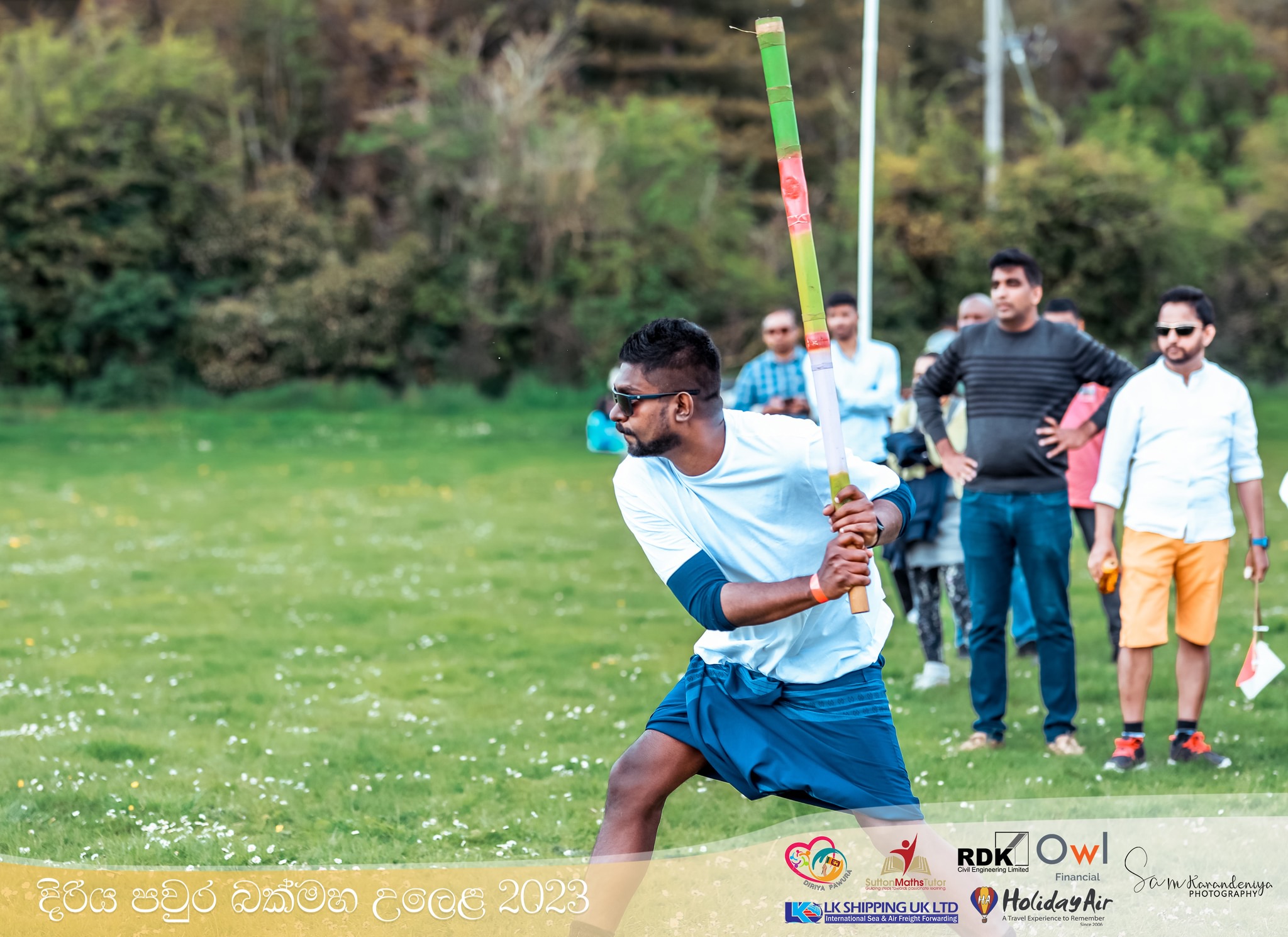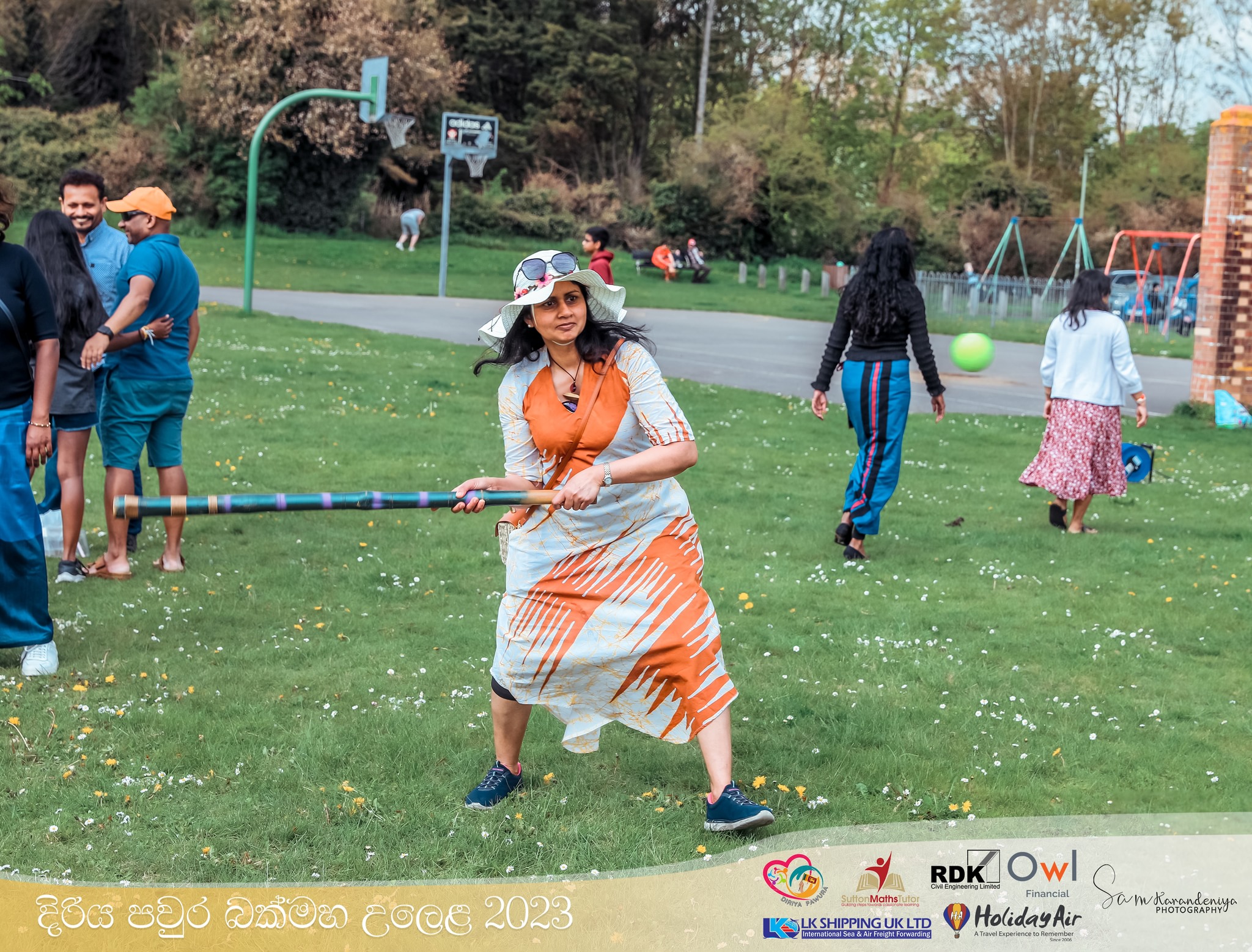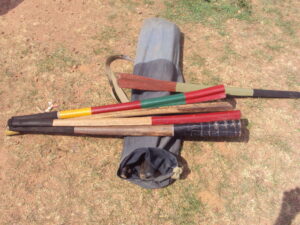
All About elle
The Sport of Elle
Sri Lanka’s Bat and Ball Game
Elle is a Sri Lankan bat-and-ball game. Hitters are given three chances to successfully hit the ball. After hitting the ball with a bamboo stick, the hitter must complete a circular run that includes four possible stopping points, each placed 55 meters apart.
There are a few ways a hitter can get out:
- Catch: If a fielder catches the ball after it’s been hit.
- Tag: If a fielder hits the runner with the ball before the runner reaches a stopping point.
- Stopping: The hitter may only stop at one of the three designated stopping points during the run. If they don’t, they can be tagged out.
The hitter’s successful run allows another member of their team to take over as hitter. The team with the most completed runs at the end of the match wins.
Popularity
Elle was once the most popular sport in the coastal regions of Sri Lanka’s Western and Northwestern Provinces. Many Elle clubs were formed in the early 20th century, and the game was highly competitive. Weekend matches drew large crowds of passionate spectators, earning Elle the nickname “The Poor Man’s Game.” The rivalry between teams was generally healthy and friendly, though occasional tensions would flare.
Rules of Play
- Team Size: Teams consist of a maximum of 16 players and a minimum of 12. Teams do not need to match the number of players on the opposing side. Additional players can be added before the start of the third inning.
- Batting/Fielding Order: The team that wins the coin toss decides whether to bat or field first.

Origin of Elle
The exact origin of Elle is uncertain, with no clear records of when, where, or by whom it was first introduced. However, evidence suggests that the game existed in Sri Lanka before the 20th century. Elle was a popular pastime for thousands of years and even became Sri Lanka’s national sport between 1970 and 1990. It is believed to have been created by Sri Lankan ancestors over two thousand years ago. Today, while not as widespread, Elle remains actively played in districts like Colombo, Gampaha, and Puttlam, with dedicated players and supporters.
Humble Beginnings
In its earliest forms, Elle was played with simple materials. Players used sticks as bats and sometimes a dried Wel Kaduru fruit as a ball. Primarily a game for rural workers, Elle provided leisure and entertainment after a hard day’s work in the fields.
Growth and Community
Elle fostered a strong sense of community. Entire villages would divide into teams, including both men and women, for friendly competition. Children would emulate their parents, learning the game from a young age. Tournaments between neighboring villages brought excitement and a chance to socialize. Players and spectators shared ideas and food, creating a strong sense of togetherness and camaraderie. Despite the rivalry on the field, these events were known for their hospitality and good spirit.
History of Elle
The exact origins of Elle remain uncertain. However, evidence like a 1911 team photograph of the “Hendala Greyhounds” suggests the game existed in organized form before the 20th century. The players’ European-style clothing indicates the game’s popularity across social classes. The existence of Elle teams in the Hendala area hints at its deep roots within the community, often taking on a festive atmosphere.
Festive Traditions and Colonial Influence
Elle was often played on Sundays after church services, particularly in Christian areas, serving as a key part of village celebrations. Teams comprised both young and older players, and visiting teams received meals and refreshments, fostering strong community bonds.
The legacy of Sri Lanka’s colonial past is reflected in the team names of the 1940s, with titles like “Young Boys” and “Super Sixteen” demonstrating the continued influence of British culture.
Team Names and Symbolism
Modern Elle teams continue to carry symbolic names, demonstrating the game’s enduring cultural significance. Here are some categories and examples:
- Ancient Kings: Sri Vijaya, Gamini, Mahasen
- Catholic Saints: St. Sebastian’s, St Maria, St. Anthony’s
- Nature: Nagena Tharu (Rising Stars), Sandatharu (Moon and Stars), Hiru Ras (Rays of the Sun)
- Virtues: Muditha (Happiness), Eksath (United), Nirmala (Immaculate)
- Geography: Sayuru Thera (Beachfront), Kelani Nadi (River Kelani)
- Time of Day: Aruna (Dawn), Sandya (Evening)
Accessibility and Growth
Elle is an inclusive sport, enjoyed by people of all ages and genders. Its simplicity is key to its appeal: makeshift balls from fruits or dried rubber, bats from bamboo or tool handles, and playing fields found in readily available spaces.
Over the past century, Elle has evolved significantly. Standardized balls, crafted bats, official attire, designated playing fields, umpires, and detailed scorekeeping now define the modern game, moving it towards potential international recognition. This transformation honors the dedication of generations of players who’ve helped develop Elle from its humble origins.

Game Rules
Elle Ground
- The play area should be free of obstructions, especially in the running path.
- Boundaries are marked with 3cm wide lines and should be at least 5 meters behind the striking spot.
Rules and Regulations
- Out Zones: The back of the field is marked by two posts and an “OUT” line between them.
- Body vs. Equipment: Anything a player is wearing or carrying is considered part of their body for determining outs.
- Stopping/Running:
- Runners must stop completely within a designated Runner’s Rest zone.
- Runners cannot leave a Runner’s Rest until the next ball is struck.
- Striking:
- The bat must remain in the striker’s hand throughout the swing.
- A ball cannot be struck after it has bounced or touched the striker’s hand.
- Fair Play
- Teams may not intentionally block runners or hit them excessively hard with the ball.
- Runners should not intentionally obstruct fielders.
Additional Rules
- Teams share a common set of balls. Altering the balls is not permitted.
- Umpires can overturn incorrect decisions or calls where a player struck the umpire with the ball.
- Additional players listed on the roster can be added before the third inning begins. Injured players may be replaced.
- Matches may be shortened (one inning, 35 minutes, 40 balls) at the organizer’s discretion.
- While on a Runner’s Rest, runners may switch sides but cannot be hit during the switch.
- The umpire has the authority to penalize rule-breaking with outs or by awarding runs.
Player Conduct & Attire
- All players must remain 5 meters behind the striker, except the assistant runner.
- Teams found violating rules about player substitutions or ball use are considered to have forfeited the match.
- Runners can be sent back to their original Runner’s Rest if play has been temporarily halted.
- Players must wear matching uniforms with numbers. Long or short pants/trousers and long-sleeved shirts are allowed. Shoes are permitted, but no metal cleats.
- Umpires can use yellow/red cards to warn or remove players for misconduct. Removed players cannot be replaced.

Equipment Needed for Elle
Field Markers:
- Two tall posts (10 meters high), resembling bamboo trees.
- Six smaller posts (1 meter high, 2 centimeters wide).
- Eight flags to attach to the posts.
Elle Bat:
- Made from seasoned bamboo.
- Length and width can be customized to the player’s preference.
- The circumference of the bat cannot be altered.
- Non-metal materials can be used to reinforce the bat for durability.
Elle Ball:
- A standard tennis ball can be used. The fur should be removed, but do not expose the rubber core.
- A lightweight rubber ball or similar substitute is acceptable as long as both teams use the same ball.


